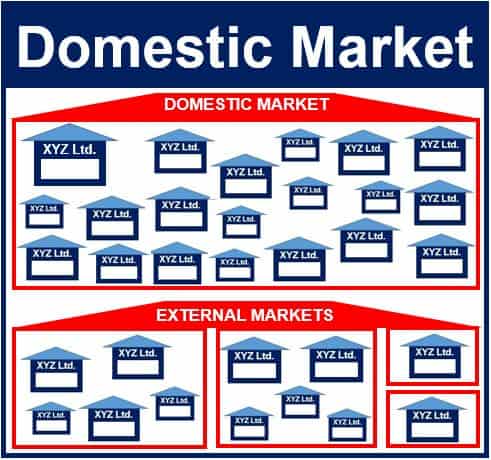What is the domestic market? Definition and meaning
The Domestic Market, also known as the Internal Market or Home Market, is where goods and services are bought and sold within the borders of a country. It is a much smaller market than the international, external, foreign, or global markets.
There is considerably less competition in the UK’s domestic market, for example, than in the European or global markets.
Despite its smaller scale, the domestic market often serves as a springboard for local businesses, nurturing innovation and stability before they scale up to the global stage.
In a domestic market, all the companies face a similar set of economic, social, competitive, market, and technological challenges.
Some businesses opt to concentrate just on the domestic market, while others choose to expand into other countries.

Domestic market may be the only choice
In some cases, the domestic market is the only one available for a specific product.
A Spanish company that makes and sells, for example, bullfighter’s outfits, will generate sales in its domestic market, but virtually none in neighbor France, the rest of Europe, or anywhere else in the world, with the exception perhaps of Mexico and some Latin American countries.
According to Cambridge Dictionaries Online, the domestic market is:
“The number of customers who buy or may buy products and services offered by companies within their own country.”

Domestic market may be too small
Some types of companies must expand abroad and cannot depend entirely on their domestic markets, because the customer base in that country is far too small.
A Swiss company that makes a unique, unrivaled, state-of-the-art prosthetic leg which allows the user to walk and run like people with natural legs, cannot focus just on the domestic market. Switzerland, with a population of just 8 million, simply does not have a large-enough customer base.
Demand globally for its unique new prosthetic leg is big enough for the company to make a profit after recouping its research and development costs.
Moreover, advancements in e-commerce and digital marketing have enabled even niche products to find a wider audience, transcending the limitations of local demand.
This shift towards digital outreach has allowed companies to personalize their approach, targeting specific demographics within the domestic market more effectively.
Geographical markets
There are many other types of geographical markets. Let’s have a look at some of them, their meanings, and how we can use them in a sentence:
-
Home Market
The home market is the economic environment in which a company originates and primarily does business, often used interchangeably with the domestic market.
Example: “Despite global expansion, the firm’s home market remains its largest source of revenue.”
-
Global Market
The global market refers to the international exchange of goods and services.
Example: “The company’s expansion into the global market increased its customer base significantly.”
-
Overseas Market
An overseas market is any market outside the country’s own borders.
Example: “They are looking to export their products to an overseas market for the first time.”
-
Local Market
A local market is the trade of goods or services within a specific area or community.
Example: “Farmers sell their produce directly to consumers at the local market.”
-
Regional Market
A regional market encompasses the trade within a particular region, which could be a part of a country or several countries.
Example: “The brand has a strong presence in the regional market of Southeast Asia.”
-
Emerging Market
An emerging market is a market that is in the process of rapid growth and industrialization.
Example: “Investors are always on the lookout for opportunities in the emerging market because of the potential for high returns.”
-
Niche Market
A niche market is a focused, targetable portion of a market that addresses a specific customer need or preference.
Example: “The company found success by concentrating on a niche market for organic skincare products.”
-
Mature Market
A mature market is one where the product or service category has been fully integrated into the economy, with slow growth and stable consumer bases.
Example: “In the mature market for smartphones, innovation is key to winning over consumers.”
Two Videos
These two educational videos come from our sister channel on YouTube – Marketing Business Network. They explain what the terms “Domestic Market” and “Market” mean using easy-to-understand vocabulary and examples.
-
What is the Domestic Market?
-
What is a Market?

